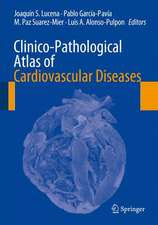ECG: An Introductory Course A Practical Introduction to Clinical Electrocardiography
P. Schumacher Autor M. J. Halhuber Traducere de H. J. Hirsch W. Newesely Autor R. Günther, M. Ciresaen Limba Engleză Paperback – iul 1979
Preț: 360.14 lei
Preț vechi: 379.09 lei
-5% Nou
Puncte Express: 540
Preț estimativ în valută:
68.92€ • 71.69$ • 56.90£
68.92€ • 71.69$ • 56.90£
Carte tipărită la comandă
Livrare economică 15-29 aprilie
Preluare comenzi: 021 569.72.76
Specificații
ISBN-13: 9783540093268
ISBN-10: 3540093265
Pagini: 172
Ilustrații: XII, 158 p. 6 illus.
Dimensiuni: 133 x 203 x 9 mm
Greutate: 0.2 kg
Editura: Springer Berlin, Heidelberg
Colecția Springer
Locul publicării:Berlin, Heidelberg, Germany
ISBN-10: 3540093265
Pagini: 172
Ilustrații: XII, 158 p. 6 illus.
Dimensiuni: 133 x 203 x 9 mm
Greutate: 0.2 kg
Editura: Springer Berlin, Heidelberg
Colecția Springer
Locul publicării:Berlin, Heidelberg, Germany
Public țintă
ResearchCuprins
1. Vectorcardiography.- 2. Usual ECG Leads and Their Interrelation.- 3. Interpretation of the “Electric” Axis of the Heart.- 4. The Normal ECG.- 4.1 The P Wave.- 4.2 The AV Interval (PQ or PR).- 4.3 The QRS Complex.- 4.3.1 QRS Amplitude.- 4.3.2 QRS Duration.- 4.3.3 QR Interval (Intrinsicoid Deflection).- 4.4 The ST-T Segment.- 4.5 The T Wave.- 4.6 The QT Interval.- 4.7 The U Wave.- 5. Memory Aid to Systematic ECG Description and Evaluation.- 6. Ventricular Conduction Disorder — Bundle Branch Block.- 6.1 Unifascicular Block.- 6.2 Bifascicular Bundle Branch Block.- 6.3 Trifascicular Blocks.- 7. The WPW Syndrome.- 8. ECG in Hypertrophy of Individual Chambers of the Heart.- 8.1 ECG in Hypertrophy of the Atria.- 8.2 ECG in Hypertrophy of the Ventricles.- 8.2.1 Depolarization.- 8.2.2 Repolarization.- 8.2.3 Position of the Cardiac Axis.- 9. ECG in Myocardial Infarction.- 9.1 Hypotheses of Necrosis, Injury, Ischemia.- 9.2 Sites of Myocardial Infarction.- 9.3 Course and Classification of Infarcts.- 9.4 Differential Diagnosis of the ECG in Myocardial Infarction.- 9.5 Infarct and Bundle Branch Block.- 10. Changes in the ST-T Segment.- 10.1 Causes of ST-T Changes.- 11. Exercise ECG.- 11.1 Changes in the Exercise ECG Suggestive of Coronary Disease.- 11.2 Doubtful and Prognostically Unreliable Changes in the Exercise ECG.- 11.3 Absolute Contraindications to the Exercise Tolerance Test or Bicycle Dynamometry.- 11.4 Relative Contraindications.- 11.5 Criteria for Discontinuance.- 12. ECG Diagnosis of Arrhythmias.- 12.1 Are (normal) P Waves Present?.- 12.2 What is the Distance Between Individual P Waves?.- 12.3 What is the Shape of the P waves?.- 12.4 What is the Distance of P Waves from the Following QRS Complex?.- 12.5 What is the Distance Between Apparently Identical VentricularComplexes?.- 12.6 What is the Time Relation of Differently Shaped Ventricular Complexes to Each Other or to the Basic Rhythm?.- 12.7 Incidence of Different Types of Arrhythmia.- 13. Pacemaker ECG.- 13.1 Fixed-Rate Pacemakers.- 13.2 Demand Pacemakers.- 13.3 Atrial-Triggered Pacemakers.- 13.4 Bifocal Demand Pacemakers.- 13.5 Complications After Pacemaker Implantation.- 14. ECG in Children.- 14.1 Normal Development of ECG as a Whole.- 14.2 Characteristic Patterns of Childhood Tracings.- 14.3 Effects of Extracardiac Factors.- 14.4 Technical Difficulties.- 15. Technique of ECG Recording.- 16. Concluding Cautionary Remarks on ECG Interpretation.- 16.1 Cardiac Arrhythmias.- 16.2 Diagnosis of Infarction.- 16.3 Suspected Hypertrophy of Individual Parts of the Heart.








